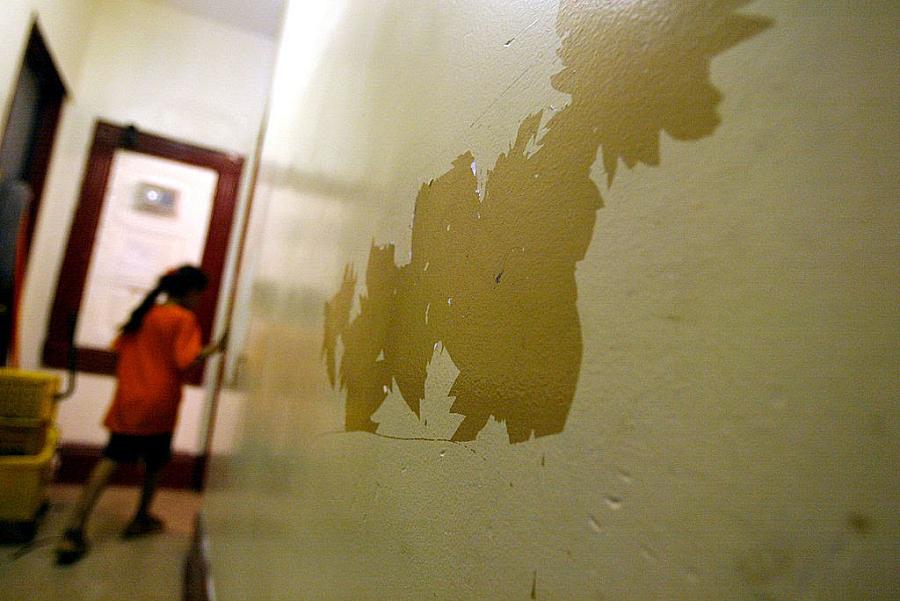The Health Divide: Lead is a threat to all kids, but especially Black children and those living in poverty
Image

(Photo by Spencer Platt/Getty Images)
Published on
April 7, 2025
Despite a ban on lead-based paint in the United States for nearly half a century, public schools still struggle with this toxin, which can pose serious health risks to students and staff.
According to a survey report from the U.S. Government Accountability Office (GAO), 12% of school districts underwent inspections for lead-based paint during the 2016-2017 school year. Alarmingly, half of the inspected districts tested positive for lead in their buildings.
Efforts eliminate lead hazards have been initiated in various districts, but the hazards remain challenging to eradicate.
Milwaukee is the latest city to face a lead paint problem. In March, three schools were temporarily closed for thorough cleaning and testing due to safety concerns. So far this year, nearly a dozen Milwaukee Public Schools have been cleaned for lead, with more expected to be added to the list.
In Wisconsin and elsewhere, the risks of lead poisoning aren’t borne equally by all students. Black children and kids living in households with incomes below 130% of the federal poverty level are at a higher risk, according to KFF.
Why is this the case?
Poor Black children face a higher risk of lead exposure because they often live in older homes with lead-based paint and old plumbing. In cities like Milwaukee, these kids also are more likely to attend older school buildings that once used lead-based paint.
Lead is a neurotoxin that can remain hidden, posing significant health risks to children. Even minimal lead exposure can hinder growth, disrupt cognitive development, and lead to long-term learning and behavioral issues. The effects of lead exposure can persist throughout an individual's life, impacting their overall future well-being.
While it is difficult to determine the exact number of public schools with lead contamination nationwide, a 2019 report indicated that around 15.2 million children in the United States are enrolled in school districts that have identified the presence of lead-based paint.
Image

Lead paint hazards at Golda Meir School Lower Campus in Milwaukee, Wisconsin.
(Photo via City of Milwaukee Health Department)
Despite ban, lead-based paint persists
The United States banned the manufacture and sale of lead-based paint for residential use in 1978. But more than four decades later, lead-based paint is still present in millions of homes and buildings.
While the 1978 ban primarily focused on stopping the sale of lead-based paint, it did not address the presence of lead paint in older buildings constructed before then. As a cost- and time-saving measure, most schools, businesses and homes had their lead-based paint painted over, rather than going through the tedious and expensive process of removing it.
Milwaukee provides an example of the issues faced by other racially segregated cities that have grappled with lead contamination, such as Flint, Michigan, and Philadelphia.
While children in impoverished neighborhoods are more likely to be exposed to lead, more research is needed to investigate the links between lead exposure and racial segregation.
Predominantly Black neighborhoods have consistently faced greater exposure to harmful environmental factors, such as air pollution and unsafe water facilities. The segregation of Black communities has allowed policymakers and planners to prioritize the protection of predominantly white neighborhoods, leaving marginalized communities more vulnerable to environmental hazards.
Cities like Milwaukee, Flint, and Philadelphia are instances of high levels of segregation. Historically, Milwaukee has been recognized as one of the most segregated cities in the country and has been described as one of the worst places to raise a Black child due to crime, poverty, segregation, and economic factors.
In Milwaukee, the district’s oldest school, Brown Street Academy, is 140 years old. Of the 204 students enrolled at this school, 90.7% are Black and 7.4% are Hispanic.
Brown Street Academy is one of several buildings that the Milwaukee Health Department identified as having lead hazards, resulting in a temporary closure and remediation efforts. The school ranks in the bottom 50% of all schools in Wisconsin for overall test scores, with math proficiency and reading proficiency both in the bottom 50%. We can’t say lead causes those lower rankings, but at the very least we can say it doesn’t help, given what we know about lead’s harmful effects on brain development.
Another issue facing Black and Hispanic youth in Milwaukee is that many live in older homes built before 1978 on both the city’s north and south sides. According to a study by Freddie Mac, the Milwaukee metropolitan area contains the oldest housing stock in the nation. Over 80% of its housing units were constructed before 1980, according to a 2018 survey.
“We can say, ‘Yes, there's peeling paint. Yes, there are old drinking fountains. Yes, there's dust piled in that corner.’ But we don't know the exact extent of the exposure until we get all our kids tested,” said Tyler Weber, Milwaukee Health Department’s Deputy Commissioner for Environmental Health.
‘Toxic City: Sick Schools’ project led to changes
In 2018, Philadelphia Inquirer and Daily News reporters tackled the lead problem in their city’s schools. Their investigation, "Toxic City: Sick Schools,” was recognized as a finalist for the 2019 Pulitzer Prize.
Their reporting, which took place under the auspices of the Center for Health Journalism’s National Fellowship, prompted Gov. Tom Wolf to allocate nearly $16 million for the urgent removal of lead paint and other hazards at 40 schools. The remaining funds would be used to eliminate asbestos fibers in several district schools and upgrade outdated heating and cooling systems to mitigate mold issues.
Throughout the nine-month investigation, which relied on community-based testing, the reporters uncovered 9,000 environmental issues in the city’s public schools. Teachers and staff collected samples for testing, as did the reporters.
Dean Pagan, then 6 years old, was severely lead-poisoned at Watson Comly Elementary School in Northeast Philadelphia and became the face of the project. In 2019, Pagan’s parents filed a lawsuit against the school district and the city, alleging they failed to protect their first-grade child from dangerous conditions at school. The suit also mentions that they failed to warn students, parents, and teachers about the lead and neglected to promptly fix or clean up known lead hazards.
As public health journalists, there is so much more reporting to be done on lead contamination — especially in public schools. Given that many school buildings were constructed before regulations against lead-based paints were enacted, this is a story with legs in countless communities across the country.
Reporters can pose specific questions to public officials. For instance: “Was this school built before 1978?” “How many school buildings in your city were built before 1978?” These questions can help reporters assemble some basic data locally, and identify potential risks of lead exposure.
If buildings were constructed before the 1980s, reporters can verify whether they contain hazardous materials, such as asbestos, that could pose a risk to students and staff.
Another key question is water safety: “When was the last time the district tested the drinking foundations for pollutants such as lead?” Ensuring drinking water is free of lead is just as crucial as assessing the buildings.
As journalists, we have a vital role in promoting the safety and well-being of children, teachers, and school staff. This kind of reporting can help create a safer future for our schools, even as federal oversight and funding seems more uncertain than ev

